


SITE LOGIN
-
REVIEWS
- Ski Gear
- Clothing
- Accessories
- Off-Season Gear
- Lifestyle
- Lodges and Accommodation
- Nutrition
- Manufacturers
- Destinations
- Training
- Gear of the Year
- Best New Summer Gear
-
Holiday Gift Guide
-
Holiday Gift Guide 2024
- Holiday Gift Guide 2024 Base Layers
- MSR Explore Revo Snowshoes
- Fieldsheer Backcountry Heated Jacket
- Fieldsheer Premium 2.0 Merino Heated Socks
- MEC Hut Booties and Slippers
- Arc’teryx Kopec GTX Shoe
- Arc’teryx Kragg Insulated Approach Shoes
- Gregory Verte 18 Backpack
- Grundens Deck-Boss Ankle Boot
- MEC Northern Light Vest
- Montec-Scope-Ski-Goggles
- Mountain Hardware Kor Airshell Hoody
- Mountain Hardware Kor Alloy Crew
- Arcade Atlas Belt
- Dynafit Ridge Dynastretch Jacket
- Shokz OpenRun Pro 2 headphones
- Buff Merino Move Multifunctional Neckwear
- Bootdoc Foot Warmer
- Cotopaxi Allpa 42L Travel Pack
- DPS LastBag
- DPS PHANTOM Glide At-Home Kit
- DPS Mission Quiver Roller
- Dragon Amped sunglasses
- Dragon DX3 Plus OTG photochromic goggle
- Fuse Lenses Anclote Flashback
- Garmin Fenix 8 Solar Sapphire Watch
- Gregory Alpaca Gear Tote 30
- Hotronic Boot Dryer
- MEC Aluminum Pot Set
- Gnara Go There Pants
- Grundens Shackleton 2.0 Duffel
- Jones Deeper 19L Backpack
- Le Bent Core Midweight Crew base layer
- Leatherman ARC
- Montane Nordes Hooded Softshell Jacket and Pants
- Helly Hansen Odin Everdown Hooded Jacket
- Helly Hansen Verglas Infinity Shell Jacket 2.0
- Montec Fawk Ski Jacket
- Pomoca Free Pro 2.0 Skins
- Rab Glaceon Pro Down Jacket
- Rab Khroma Converge GORE-TEX Ski Jacket & Pants
- Smith Squad MAG Goggles
- Stellar Guide Aerogel Hybrid Hood 2.0
- Stellar Ultralight Down Hood 2.0
- Arms of Andes Alpaca Half Zip & Wool Leggings
- Cotopaxi Allpa 70L Duffel Bag
- Giro Taggert Mips Helmet
- Loonr Hi Flyer Boots
- Paka Mountain Crew
- Roll Recovery SUPERPLUSH Classic Shoes
- Smartwool Smartloft Hooded Jacket and Pants
- Ortovox Switchback 32 Ski Touring Backpack
- Cotopaxi Allpa X 3L Hip Pack
- Giro Sagen Ski Goggle
- Icebreaker Ski+ Over the Calf Socks
- MEC-Fireside-Fleece-Snap-Pullover
- Montec Roast Mittens
- Mountain-Hardware-Sunblocker-Hoody
- MSR Titan Kettle 900 ml
- Tailgate-Industries-The Gondom-Goggle-Cover
- Wild Country Rope Tarp
- Bootdoc Race Merino PFI 50 Socks
- Remind Soles Destin Impact Insoles
- Kari Traa Rose Baselayer Half Zip Top and Pants
- Le Bent Midweight Quarter Zip
- Ombraz Dolomite Sunglasses
- Ortovox Fleece Rib Hoody
- Ortovox Merino Thermovent Base Layer
- Smartwool Intraknit Merino Tech Half Zip
- Suunto Wing Bone Conduction headphones
- Sweet Protection Adapter Mips Helmet
- Sweet Protection Connor Rig Reflect Goggles
- Zeal Optics Selkirk Glacier Glasses
- Norrona more flex1 Pants
- Norrona Octa Zip Hood
- Norrona Lyngen Alpha100 Zip Hood
- MEC Deluxe Pillow
- Holiday Gift Guide 2023
- Holiday Gift Guide 2022
- Holiday Gift Guide 2021
- Holiday Gift Guide 2020
- Holiday Gift Guide 2019
- Holiday Gift Guide 2018
- Holiday Gift Guide 2017
- Holiday Gift Guide 2016
-
Holiday Gift Guide 2024
- Pro Skier Interviews
- NEWS
- STORE
- ROUTES
- LODGING
-
VIDEOS
- 2022/23 Gear Reviews
- 2021/22 Gear Reviews
- 2020/21 Gear Reviews
- 2019/20 Gear Reviews
- 2018/19 Gear Reviews
- 2017/18 Gear Reviews
- 2016/17 Gear Reviews
- 2015/16 Gear Reviews
- 2014/15 Gear Reviews
- 2013/14 Gear Reviews
- 2012/13 Gear Reviews
- 2011/12 Gear Reviews
- 2020 Outdoor Retailer
- 2019 Outdoor Retailer
- 2018 Outdoor Retailer
- 2017 Outdoor Presscamp
- 2017 Outdoor Retailer
- 2016 Outdoor Presscamp
- 2016 Outdoor Retailer
- 2015 SIA Show
- 2014 Outdoor Retailer
- 2013 SIA Show
- 2012 Outdoor Retailer
- Tips and Tricks
- Backcountry Skiing
- SAFETY
- ABOUT
- REVIEWS
- NEWS
- STORE
- ROUTES
- LODGING
-
VIDEOS
- 2022/23 Gear Reviews
- 2021/22 Gear Reviews
- 2020/21 Gear Reviews
- 2019/20 Gear Reviews
- 2018/19 Gear Reviews
- 2017/18 Gear Reviews
- 2016/17 Gear Reviews
- 2015/16 Gear Reviews
- 2014/15 Gear Reviews
- 2013/14 Gear Reviews
- 2012/13 Gear Reviews
- 2011/12 Gear Reviews
- 2020 Outdoor Retailer
- 2019 Outdoor Retailer
- 2018 Outdoor Retailer
- 2017 Outdoor Presscamp
- 2017 Outdoor Retailer
- 2016 Outdoor Presscamp
- 2016 Outdoor Retailer
- 2015 SIA Show
- 2014 Outdoor Retailer
- 2013 SIA Show
- 2012 Outdoor Retailer
- Tips and Tricks
- Backcountry Skiing
- SAFETY
- ABOUT
TOP VIDEOS
Pieps DSP Transceiver

The Pieps DSP avalanche transceiver has been named “Gear of the Year” for the 2011/2012 season by the Backcountry Skiing Canada testing team. Accuracy and ease of use are two of the reasons the Pieps DSP avalanche transceiver took the win, PIEPS keeps it simple and makes it work. Well done!
The Backcountry Skiing Canada Team.
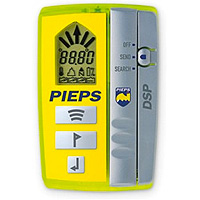 The Pieps DSP (Digital Signal Processing) avalanche transceiver is a three-antenna digital transceiver with masking capabilities. At 60 meters the Pieps DSP offers one of the longest maximum ranges on the market which will be instantly appreciated the next time you search. The DSP is full of features but keeps things super simple in the user interface realm. The digital display has 5 directional arrows to point you in the correct direction and will also display numerical distance and the number of signals detected by showing the icon of a buried person. The three antennas make quick work to guide you to the signal source and if you are required to quickly switch back to send in case of a secondary slide simply bump the off/send/search slider and the Pieps DSP goes back into send mode.
The Pieps DSP (Digital Signal Processing) avalanche transceiver is a three-antenna digital transceiver with masking capabilities. At 60 meters the Pieps DSP offers one of the longest maximum ranges on the market which will be instantly appreciated the next time you search. The DSP is full of features but keeps things super simple in the user interface realm. The digital display has 5 directional arrows to point you in the correct direction and will also display numerical distance and the number of signals detected by showing the icon of a buried person. The three antennas make quick work to guide you to the signal source and if you are required to quickly switch back to send in case of a secondary slide simply bump the off/send/search slider and the Pieps DSP goes back into send mode.
Pieps DSP in the off position.
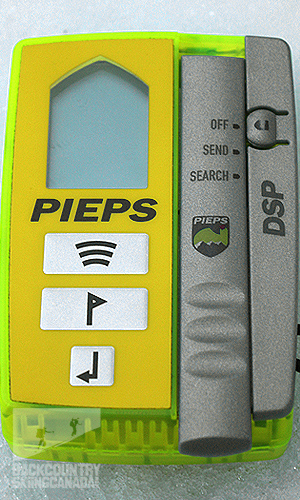
Pieps DSP in search mode, a quick bump on the switch will get you back into send mode in a flash.
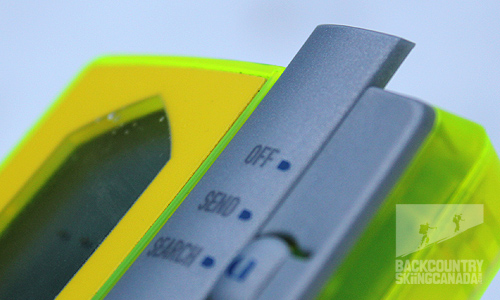
Pieps DSP in the send mode.
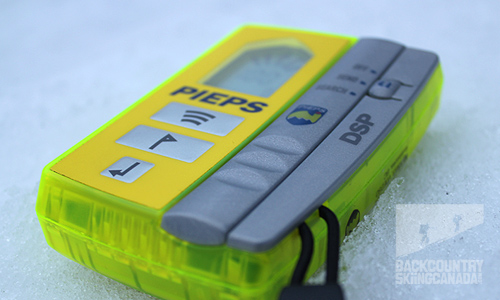
Flashing light makes for a quick check to ensure the Pieps DSP is turned on.
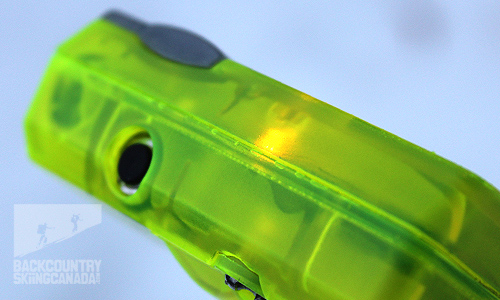
Multiple Signals:
Should you find yourself in a multiple burial scenario the Pieps DSP will show you the direction and distance to the strongest signal (typically the closest one) while displaying an icon of a buried person on the bottom of the screen for each signal it's receiving. To limit confusion you are able to mark or mask secondary signals by pressing and holding the mark button which has an intuitive flag icon on it. A box is then placed around the icon of the closest signal to show that it is now marked. The Pieps DSP will then show you the direction and distance to the next strongest signal. The ability to mark or mask signals is ideal to limit confusion and allow you to focus on one subject at a time. "Smart Transmitter" technology also helps simplify multiple signal scenarios by modifying the cadence of the DPS's transmitting signal in order to reduce the likelihood of signal overlap.
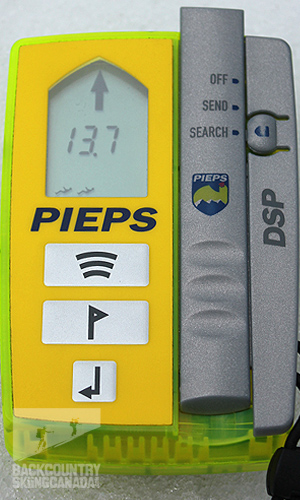
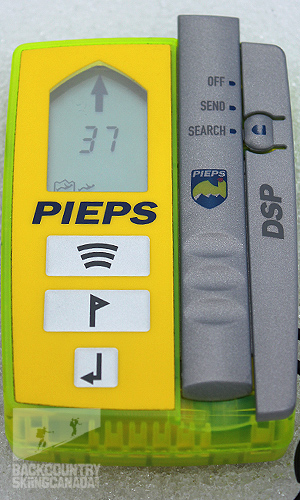
Features:
iProbe Support: The Pieps DSP has been designed to work with the Pieps iProbe which is an avalanche probe that can temporarily deactivate the DSP transceiver when it is within 50cm. This is a useful feature for multiple burial scenarios and can greatly reduce overall search times.
Firmware: The Piep DSP firmware is fully upgradable by simply taking your transceiver into an authorized dealer where they will ensure your transceiver has the latest firmware to operate from, typical cost is around $20. In October of 2011 a new software update was released - version 8.2 replaces version 6.2 with the main difference being support for the secondary frequency of the tx 600 equipment and dog transmitter.
Frequency deviation: The Pieps DSP can measure frequency deviation of any transceiver which is good group information prior to a ski tour. Prior to 1997 most transceivers transmitted at 2.275kHz, after this date the standard was that all transceivers must transmit within ±100 Hz of 457 kHz. In 2001 this variance was reduced to ±80 Hz. Older analog transceivers typically use ceramic oscillators which can easily exceed this allowance. Todays transceivers use crystal oscillators and typically fluctuate within ±30 Hz of the 457 kHz frequency however this can vary depending upon several factors. To check the frequency of other beacons press the enter button in search mode and an "F" for frequency check will be displayed. You will then see a reading and an arrow, this indicates the amount of hertz the transceiver is off, an arrow to the right indicates above 457 kHz and an arrow to the left means below.
Scan Function: The Pieps DSP has an innovative scan function which will indicate the number of signals it detects within a 5 meter, 20 meter and 50 meter radius. To initiate the scan function, press and hold the top button with the three radial lines on it for 3 seconds and the readouts will quickly follow. This is an ideal function to use when you immediately arrive on the scene of an avalanche where the number of victims are unknown. The scan only takes a matter of seconds and lets you know what you are dealing with so that you can proceed accordingly.
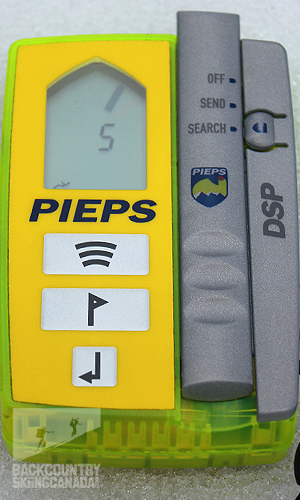

Self Check: The self check feature on the Pieps DSP uses a fourth antenna to check the transmitting frequency, the function of each antenna, the processor and the amplifiers to ensure things are functioning as intended. This self test is automatically performed upon start up each time the transceiver is powered on and takes about 5 seconds.
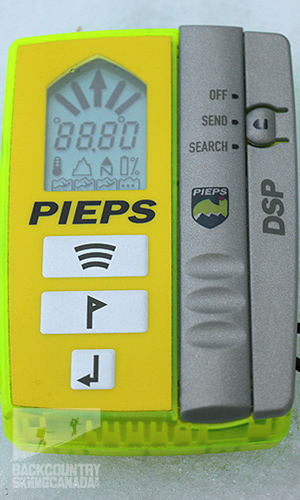

VERDICT:
I subscribe to the KISS principle – "keep it simple stupid". The success of any product is tightly aligned with how well a complex task can be achieved in a simple and timely manner. The Pieps DSP is one of such products that provides a lot of functionality within a very clean and simple interface. With a minimal three button interface the Pieps DSP is a super easy transceiver to operate even with little practice (however you should always practice, and often!). In 2003 Pieps became the first manufacturer of a three-antenna transceiver with marking capabilities thus setting the stage for all others to follow. The masking feature is very intuitive and works as stated, in our testing it was very accurate and processed information rather quickly.
The Pieps DSP has one of the longest ranges of all digital transceivers, its third antenna is excellent at dealing with spikes during deeper burials, and it handled frequency drift well.
The thing I like most about the DSP is its simplicity in dealing with a complex set of features. It also has a few other niceties which you will quickly wonder how you did without:
- solid/secure harness with room for a pencil
- updatable firmware
- scan function
- constant battery level indicator
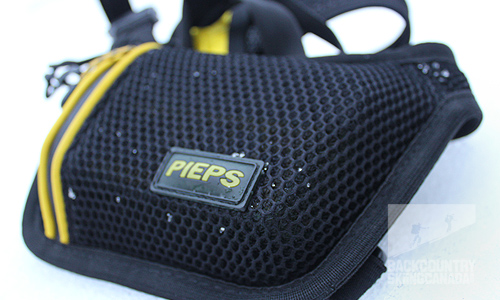
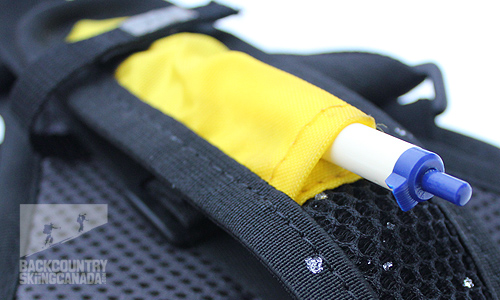
SPECS:
Retail Price: $450.00
Antennas: 3
Type: Digital
Power supply: 3 x AAA, (Battery lifetime is 200 hours in send mode)
Transmission frequency: 457 kHz (EN 300718)
Indication: Audio, LCD (direction and distance)
Maximum range: 60 m
Search strip width: 50 m
Weight: 198 g (incl. batteries)
Dimensions (LxWxH): 116 x 75 x 27 mm 4.56 x 2.95 x 1.06 in
Warranty: 2 years

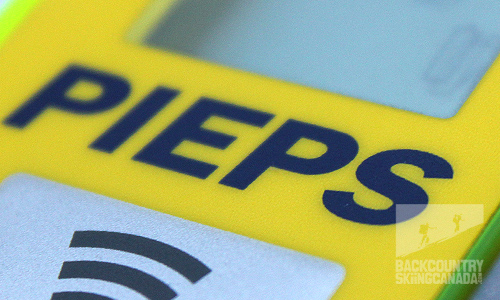
PROS:
Incorporates advanced features in a simple to use interface, great range, masking capabilities and updatable firmware.
CONS:
Harness clip would be better located on the right side of the pouch so right handed people can access it easier.
Rating: 10/10
Ease of Use 2/2
Technology 2/2
Features 2/2
Weight 2/2
Quality / Price 2/2
This is only our opinion. Do you disagree? Did we miss something? Are we totally out to lunch? Join the discussion in the forums here, and let us know what you think. People like/dislike gear for different reasons so chime in and we'll get a well-rounded evaluation.
Back to the rest of the reviews.
UPDATE APRIL 2013:
The Pieps DSP Transceiver has gotten me through two uneventful ski touring season so far (thankfully) and after using it on more than one hundred ski tours and practicing a handful of times each winter, I have found that it is a very fast, responsive and accurate transceiver. The design is fool proof and everything works as it should - no wonder it scored a perfect 10/10 and won our Gear of The Year Award. The only area of improvement I can see after this extended use is the harness, it just need to be a little larger to get the transceiver in and out a bit easier.
Copyright © 2023-24 Backcountry Skiing Canada. All Rights Reserved.







